
 Perfect
Perfect
Management will not succeed in
addressing all that is wrong in one go.
Nor should they try.
![]() The concept should be one of Continuous Improvement
through planned stages according to a well thought out strategy
aligned to the needs of the business. The diagram (right) shows
one such map where
The concept should be one of Continuous Improvement
through planned stages according to a well thought out strategy
aligned to the needs of the business. The diagram (right) shows
one such map where
the targets are outlined in blue and the
current position is outlined in orange.
This is based on the six 'scales' which can be found in the sections on the management process - by defining the desired and the current position on each of the scales, the management team can do much to reach agreement on what needs to be done, and the priorities within that.
Other tools that help in the area of 'Perfect' are:
Improvement Planning, linking the planning of improvements with the budgeting cycle
Training in tools to encourage creativity and innovation
Developing a Learning Organisation
Undertaking an annual cycle of Review & Audit,
Flag Plans, to ensure projects result in manageable benefits
and Change Management, to ensure the cycle of improvement is itself improved.
Please click on the diagram below (or on the associated text) to explore the various approaches that have been used to enhance Management's ability to 'Perfect' their organisations.
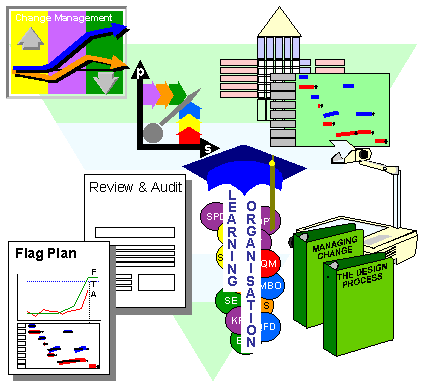
Flag Plans, Balance, Change Management,
 Improvement
should always be planned, but too often it is not a formal part
of the annual planning process - rather it is something that
is targeted at deficiency rather than proficiency.
Improvement
should always be planned, but too often it is not a formal part
of the annual planning process - rather it is something that
is targeted at deficiency rather than proficiency.
In companies that plan their improvements well as an integral part of their annual planning process, there are usually three clearly distinct stages in the planning process.
The first stage is undertaken during the strategic evaluation of the business, and involves identifying the areas of performance which would generate the greatest competitive leverage or address the biggest competitive issues. For companies that undertake their planning using QFD, this analysis occurs at the time of setting top-level QFD performance targets. Targets are set to drive the performance improvements that would be most strategically beneficial to the business - short, medium and long term (the Why-How chart can help with this analysis).
Most of these performance improvements are likely to be incremental, but some will be more radical - to generate a creative tension in certain areas of the business in order to stimulate and encourage innovation and break existing paradigms - however these should be used sparingly.
The second stage occurs when separate areas of the business (the key operating processes) agree priorities for improvement action and develop improvement plans and departmental budgets to meet these. In a QFD driven organisation this planning occurs during the cascade of the QFD, and should be an integral part of the budgeting process - all project costs and forecast benefit realisation planned in to the operating budgets of the organisation.
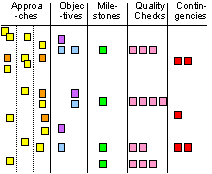 The
third stage is the detail planning of improvements within each
process. A good collective approach to doing this within a process
team is illustrated on the right hand side. First the team thinks
through the approaches they will need to take to provide the
necessary improvements (on sticky-notes), and place these in
a rough chronological order down the wall. They then link these
to clear and quantified performance objectives and delivery milestones.
The use of sticky notes helps the team to move the order of things
to make most sense and ensure early delivery of benefits. Finally
the team can clarify their thinking on the deliverables by defining
relevant quality checks and thinking through potential risks
and contingencies. This thinking helps the team to develop flag plans to help manage the quality of
the projects as well as their timeliness.
The
third stage is the detail planning of improvements within each
process. A good collective approach to doing this within a process
team is illustrated on the right hand side. First the team thinks
through the approaches they will need to take to provide the
necessary improvements (on sticky-notes), and place these in
a rough chronological order down the wall. They then link these
to clear and quantified performance objectives and delivery milestones.
The use of sticky notes helps the team to move the order of things
to make most sense and ensure early delivery of benefits. Finally
the team can clarify their thinking on the deliverables by defining
relevant quality checks and thinking through potential risks
and contingencies. This thinking helps the team to develop flag plans to help manage the quality of
the projects as well as their timeliness.
 There
are two schools of thought on creativity. Some believe that creativity
is something you are born with, ie it is part of your character,
and others believe that creativity can be taught like any other
skill. In our experience there is truth in both views.
There
are two schools of thought on creativity. Some believe that creativity
is something you are born with, ie it is part of your character,
and others believe that creativity can be taught like any other
skill. In our experience there is truth in both views.
Some people really are more creative than others - they enjoy thinking up new ways of doing things, they are not afraid of seeing things differently from others, and they often enjoy being seen as a bit bizarre and eccentric - and they need this self confidence to push forward ideas when the normal response of the 'crowd' is likely to be a put-down or ridicule (at least initially).
 But
for all people there are tools and skills that can be taught
that can enhance an individuals or teams creativity. Tools which
lead people into doing what creative individuals do naturally
- disrupting patterns, seeing things from different angles, combining
things in different ways. These tools can provide creative perspectives
for all people, and they can help naturally creative people to
move even further out in their thinking.
But
for all people there are tools and skills that can be taught
that can enhance an individuals or teams creativity. Tools which
lead people into doing what creative individuals do naturally
- disrupting patterns, seeing things from different angles, combining
things in different ways. These tools can provide creative perspectives
for all people, and they can help naturally creative people to
move even further out in their thinking.
Training is also useful in helping creative people and more straightforward down-to-earth people to recognise, value and build on each other's strengths. For good ideas to reach fulfilment requires both creative thinking and practical thinking - team training can help people recognise this and more effectively work together to bring practical innovations to benefit the business.
 The
Learning Organisation is a myth. I don't say this to ridicule
it, because it is something I very strongly believe in. But the
learning organisation is more to do with an attitude of mind
than it is to do with the approaches and tools that are currently
being marketed under this heading.
The
Learning Organisation is a myth. I don't say this to ridicule
it, because it is something I very strongly believe in. But the
learning organisation is more to do with an attitude of mind
than it is to do with the approaches and tools that are currently
being marketed under this heading.
So what is wrong with the tools? Nothing. The tools can really help a company to organise its thinking, to collect and make experience readily available, to provide the best solutions to company problems. The tools do a tremendous amount to further the concept of 'Predict' and make it a practical and powerful reality.
They are very good tools, as were the tools provided in support of Total Quality, Business Process Reengineering etc., and if they are used with the right attitude they will greatly profit the organisation that uses them.
Tools are just tools. Many have existed for years. And whatever the starting point of the company is, eventually they will need tools to undertake all of the six aspects of systematic management - look at any successful implementation of TQM or BPR and you will see that. The feature that makes an organisation a Learning Organisation is their attitude to those tools.
When a learning organisation
takes on a new tool or idea: it will recognise that it needs
to put effort into adapting the tool to its own use, and in adapting
itself to the tool; it will invest time in finding out how to
develop the tool to fulfil its full potential in their particular
situation; it will see the tool as merely a stepping stone that
will need to be built on; and where the tool fails in some way
the learning organisation will look to itself to see how it could
have done things better.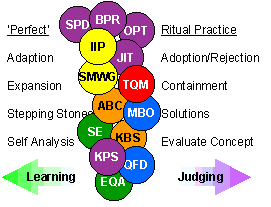
The diagram on the right contrasts this with the attitude that is all too prevalent in organisations - where the company is looking for a solution, and will see any shortcomings as a reflection on the tool rather than their own implementation of it. What is the point in judging the tool? Where is the learning in that?
In the truly learning organisation, the tools promoted under that name make a lot of sense in terms of organising and presenting the learning - but the first step has to be a learning attitude. Do you know how many of your company's recent attempts to introduce new approaches resulted in real learning for your company?
 Review
and Audit is perhaps the most useful device a company that really
wants to learn about itself can employ. The concept of Review
and Audit is an annual health check, looking in depth at customer
and employee perspectives on the general strengths and weaknesses
of the business, and in particular on the implementation of recent
initiatives.
Review
and Audit is perhaps the most useful device a company that really
wants to learn about itself can employ. The concept of Review
and Audit is an annual health check, looking in depth at customer
and employee perspectives on the general strengths and weaknesses
of the business, and in particular on the implementation of recent
initiatives.
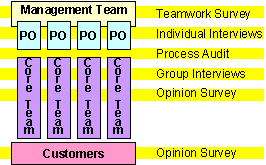 The
Review and Audit often consists of a number of elements (see
diagram on right). At the top level of the business it is likely
to involve individual interviews to elicit the opinions of the
top-team on how things can be improved, and on any teamwork or
development issues. At other levels of the business it is likely
to involve group interviews, supported by a paper survey in order
to gain a degree of quantification. It may also include some
type of objective audit to understand the extent to which prescribed
practices are being followed.
The
Review and Audit often consists of a number of elements (see
diagram on right). At the top level of the business it is likely
to involve individual interviews to elicit the opinions of the
top-team on how things can be improved, and on any teamwork or
development issues. At other levels of the business it is likely
to involve group interviews, supported by a paper survey in order
to gain a degree of quantification. It may also include some
type of objective audit to understand the extent to which prescribed
practices are being followed.
The content of these interviews and surveys is likely to explore all the aspects of a systematic approach, and example materials can be found in the resources section.
 The
review and audit should culminate in a workshop to agree what
learning should be adopted out of the results, and how it should
be implemented. In many companies this workshop is arranged to
be coincident with the annual planning cycle so that the learning
can be incorporated into next years plans.
The
review and audit should culminate in a workshop to agree what
learning should be adopted out of the results, and how it should
be implemented. In many companies this workshop is arranged to
be coincident with the annual planning cycle so that the learning
can be incorporated into next years plans.
 Flag
Plans provide a very useful means of driving serious thought
during the planning phase of an improvement project, and of ensuring
the quality of results during the implementation phase.
Flag
Plans provide a very useful means of driving serious thought
during the planning phase of an improvement project, and of ensuring
the quality of results during the implementation phase.
In 'normal' planning, the planners are merely required to set out the dates milestones are to be met, and then project management concerns itself with ensuring the milestones are met on time. There is little to say whether the deliverables are of the right quality or whether they have been successfully harnessed in delivering the required performance benefits.
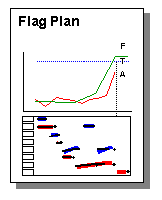 A
'Flag Plan' takes this planning one stage further. Not only are
the planners required to set dates for the milestones, but they
are required to forecast the intended performance benefits that
will result. This requires serious consideration of the milestones
and the quality criteria of the deliverables.
A
'Flag Plan' takes this planning one stage further. Not only are
the planners required to set dates for the milestones, but they
are required to forecast the intended performance benefits that
will result. This requires serious consideration of the milestones
and the quality criteria of the deliverables.
Project management then concerns itself not only with meeting milestones, but with monitoring the resulting performance benefit. And any shortfall has to be analysed, and a corrective action plan put in place. The overall objective is thus kept very clearly in the mind of the project team, and helps to mitigate against a task focus.
An example flag plan is shown to the right. The standard Gantt chart is surmounted by a plot of how the performance will change during the project lifetime. Actual performance is monitored against this and shortfalls are used to explore and understand any unforeseen issues.
 Tom
Peters once said that in his experience change initiatives largely
failed due to one of two conditions: passion without system;
or system without passion. Kevin Parker likened Change to climbing
a greasy pole - the passion is the energy you need to force yourself
up it - and the systems are the pegs you hammer in to stop yourself
sliding back down.
Tom
Peters once said that in his experience change initiatives largely
failed due to one of two conditions: passion without system;
or system without passion. Kevin Parker likened Change to climbing
a greasy pole - the passion is the energy you need to force yourself
up it - and the systems are the pegs you hammer in to stop yourself
sliding back down.
It is clear that successful change
requires a balanced approach. Without system the passion can
lead to anarchy, confusion, conflict, disillusionment, and eventual
failure. Without passion the system becomes bureaucratic, stifling,
deadening, and eventually a failure.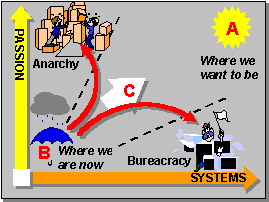
Any change needs to be designed to ensure that there is a balance of passion and systems. As an example systematic management has three aspects that are largely of 'passion' origin: Purpose, Philosophy and People; and three that are largely of 'system' origin: Process, Predict and Perfect. But you may also notice that within all six there lies the possibility of encouraging both system and passion.
Companies that are successful in change evaluate their plans to ensure that effort is planned in to both ensure the system and to stimulate and harness the passion. It is an easy task to do - just stick blue dots against activities designed to establish and reinforce the system, and red dots against the activities designed to stimulate and encourage the passion, and then review the whole thing to see if you can achieve a more practical and effective balance.
 When
people look back on failed change initiatives, and you ask them
the question "Back when you agreed to go ahead with this,
which of you would have bet £500 of your own money on its
success?" it is amazing how few agree that they would. Somehow
we embark on things without making sure that we have stacked
the deck for success.
When
people look back on failed change initiatives, and you ask them
the question "Back when you agreed to go ahead with this,
which of you would have bet £500 of your own money on its
success?" it is amazing how few agree that they would. Somehow
we embark on things without making sure that we have stacked
the deck for success.
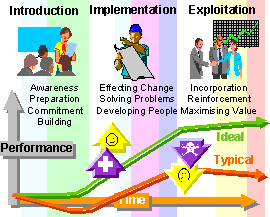 The
previous section concerned the balance
of Passion and Systems. These two aspects are further explored
here. Passion can either be increased or diminished by events
- we might call the things that increase passion 'updrivers',
and they could include 'involvement', 'understanding', 'personal
benefit' etc. But these would be mitigated against by the 'downdrivers'
such as 'fear', 'confusion', 'discomfort' etc. If you think about
it you can probably name a lot more.
The
previous section concerned the balance
of Passion and Systems. These two aspects are further explored
here. Passion can either be increased or diminished by events
- we might call the things that increase passion 'updrivers',
and they could include 'involvement', 'understanding', 'personal
benefit' etc. But these would be mitigated against by the 'downdrivers'
such as 'fear', 'confusion', 'discomfort' etc. If you think about
it you can probably name a lot more.
It is often the 'systems' of the company that give rise to these 'updrivers' and 'downdrivers'. Some work positively and we might call these 'catalysts'. They would include 'training', 'awareness sessions', 'counselling' etc. But others, the 'poisons', such as 'secrecy', 'unfairness', and 'disregard', act against the 'updrivers' and enhance the 'downdrivers'. Each phase of change has different 'catalysts', 'poisons', 'updrivers' and 'downdrivers'. (see diagram right)
This is all fairly obvious, but
the point is these things really do exist (we know, we've suffered
them!) and because of this they need to be controlled. And yet
very few companies have an active approach to manage them within
their change programmes 
The approach we would recommend is to look back at an initiative that failed to achieve its full potential, and explore the feelings of those people who had to work on it, or work with it, in terms of the four factors listed above. Look at it for each of the three phases of the initiative: Introduction, Implementation and Exploitation - and then use the understanding developed from this to improve the planning for your next initiative. One tool that will help you in this is the Force Field Analysis which can be found in the Problem Solving Tools guide in the resources section.
© Tesseract Management Systems Ltd 2003
(click below for an oversight)
Case studies of success
Managing by Design
- a handbook of
Systematic Mgt.
(purchase on line)
Transforming performance through QFD
(insight)
Testimonials on systematic management
(for Perfect)
Overview
Principles
Self-Evaluation